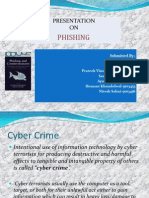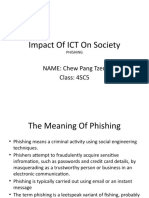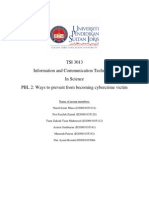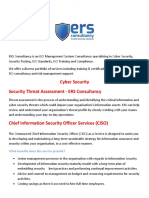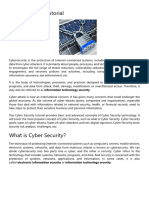Cyber Security Infographics
Cyber Security Infographics
Uploaded by
cjtwedding2020Copyright:
Available Formats
Cyber Security Infographics
Cyber Security Infographics
Uploaded by
cjtwedding2020Original Title
Copyright
Available Formats
Share this document
Did you find this document useful?
Is this content inappropriate?
Copyright:
Available Formats
Cyber Security Infographics
Cyber Security Infographics
Uploaded by
cjtwedding2020Copyright:
Available Formats
Are You #CyberSure?
Be #CyberSure with our quick information security guide against online scams. At the end of this,
we hope to equip you with knowledge on how you can protect yourselves from phishing.
What is Phishing?
Phishing is a type of online scam where fraudsters pretend to be a legitimate company to get
your information and use it for unauthorized transactions. Phishing messages trick a user into
doing certain actions, such as downloading harmful software, clicking malicious links, or
disclosing confidential data or personal information like login credentials.
What are the kinds of Phishing?
• Email Phishing
The most common type of phishing sent via email. It usually informs you that there
has been a compromise to your account and that you need to respond immediately
• SMS Phishing (or Smishing)
The attack is carried out via text message. This tactic usually sends a clickable link
where you will be redirected to a phishing website, and will ask you to login and
provide your information
• Voice Phishing
Accomplished through a phone call. A typical vishing attack includes a phone call from
someone posing as a representative of a legitimate company.
What information do they want to get?
1. Username and Password
2. OTP (One-Time-Password)
3. Card Details such as card number, expiry date and CVV
Take note: These information are for your eyes only!
How can you tell if it is Phishing?
• Sender’s email address does not match the name of the company they’re imitating.
• Messages contain poor spelling and grammar. Emotions such as fear, curiosity, urgency, and greed are also used to
persuade recipients to open attachments or click on links.
• Asks you to click on links that lead to a site where you’ll input your User ID and Password, One Time Password (OTP),
Card Details or other sensitive information.
.
What happens if you get Phished?
• Fraudsters will be able to login to your bank account and steal money from you
• Fraudulent charges can be done on your credit cards.
• Cybercriminals can steal your personal information and use it to commit fraud or other crimes.
How can you protect yourself?
• Always check and verify the sender or caller.
• Do not open or answer emails, text messages or voice calls you are not expecting.
• Don't click on links from unknown sources.
• Do not share your information such as your UB Online username or password and
OTP to anyone.
• Use different emails, user IDs, and passwords across your online accounts.
• Make sure your passwords are strong and unique. Switch on Multifactor
Authentication such as face ID, fingerprint or OTP on all your online accounts
• Monitor your online accounts regularly. Enable your notifications on your device and
online accounts.
• Stay informed. Inform yourself about any known phishing scams that are currently
circulating.
And that’s a wrap!
You just completed this #CyberSure security knowledge walkthrough.
By signing this document, you confirm that you fully understand the risks and best practices to
protect your UnionBank online accounts.
_________________________________
SIGNATURE OVER PRINTED NAME
_________________________________
DATE
You might also like
- Phishing: Not The Kindof Fishingur UsedtoDocument23 pagesPhishing: Not The Kindof Fishingur UsedtoPriyankaNo ratings yet
- BASSSecurity TipsDocument7 pagesBASSSecurity TipsAsad AliNo ratings yet
- Phishing Attack 1729031298Document5 pagesPhishing Attack 1729031298saul FloresNo ratings yet
- Phishing: Chandan.R.K B.SC (Csme) 18Cs3K042Document10 pagesPhishing: Chandan.R.K B.SC (Csme) 18Cs3K042Chandan R KNo ratings yet
- Phishing PDDocument22 pagesPhishing PDAyush DargarNo ratings yet
- Cyber Awareness During Covid-19Document47 pagesCyber Awareness During Covid-19jahanavi prajapatiNo ratings yet
- Cyber Security - Chapter 1Document40 pagesCyber Security - Chapter 1DiptiNo ratings yet
- Task PDFDocument7 pagesTask PDFgeceneNo ratings yet
- MH CYBER PresentationDocument62 pagesMH CYBER PresentationSiddhesh KarekarNo ratings yet
- Online Fraud - Types of Online Fraud - PreventionDocument8 pagesOnline Fraud - Types of Online Fraud - PreventionLumiverse SolutionsNo ratings yet
- FRAWDFRAWDDocument35 pagesFRAWDFRAWDhansiajerryNo ratings yet
- Types of Cyber CrimesDocument34 pagesTypes of Cyber Crimesnahashon kiarieNo ratings yet
- Careersource Suncoast Security Awareness TrainingDocument32 pagesCareersource Suncoast Security Awareness Trainingapi-213329838No ratings yet
- Cyber CrimeDocument10 pagesCyber CrimeKhyati MouryaNo ratings yet
- PHISHINGDocument19 pagesPHISHINGarshiahassanahmedNo ratings yet
- The Meaning of PhishingDocument14 pagesThe Meaning of PhishingAdrien ChewNo ratings yet
- What Is CybercrimeDocument5 pagesWhat Is CybercrimeJusnisalNo ratings yet
- GR5 - Principles of Information SecurityDocument11 pagesGR5 - Principles of Information SecurityVân Anh TrầnNo ratings yet
- Research PaperDocument8 pagesResearch Paperसुधा गायत्रीNo ratings yet
- Chapter 5-EsecurityDocument15 pagesChapter 5-EsecurityharshawarnakulasooriyaNo ratings yet
- Cybersecurity Training:: Safeguarding Our Firm and Client AssetsDocument44 pagesCybersecurity Training:: Safeguarding Our Firm and Client AssetsWisnu AjiNo ratings yet
- What Is Phishing AttackDocument19 pagesWhat Is Phishing AttackJay ZacariasNo ratings yet
- Research PaperDocument9 pagesResearch Paperसुधा गायत्रीNo ratings yet
- Information Technology As Level Chapter 4Document10 pagesInformation Technology As Level Chapter 4HeenaNo ratings yet
- Phishing (Norfahana)Document10 pagesPhishing (Norfahana)arashaimanNo ratings yet
- Online ThreatsDocument3 pagesOnline ThreatsZukuchiKenNo ratings yet
- VishingDocument10 pagesVishingvinayaartalaNo ratings yet
- Social Engineering Fraud - Questions and Answers PDFDocument4 pagesSocial Engineering Fraud - Questions and Answers PDFLilly Lunita AvilesNo ratings yet
- Phishing: These Phish Bite!Document13 pagesPhishing: These Phish Bite!ivanpmnNo ratings yet
- CybersecDocument78 pagesCybersecbharatNo ratings yet
- Cybercrime: Name: Suraj Satpathy Reg No: 200415140037Document2 pagesCybercrime: Name: Suraj Satpathy Reg No: 200415140037Suraj SatapathyNo ratings yet
- ICT Lecture.15Document16 pagesICT Lecture.15emannaveed2004No ratings yet
- Detecting Preventing Phishing AttackDocument18 pagesDetecting Preventing Phishing Attackkushamrathee15No ratings yet
- Cyber Safety AwarenessDocument16 pagesCyber Safety AwarenessTowhidul AlamNo ratings yet
- Phishing, Pharming, Vishing and SmishingDocument2 pagesPhishing, Pharming, Vishing and SmishingHussain100% (1)
- LK Fraud Awareness PDFDocument3 pagesLK Fraud Awareness PDFCaine RodrigoNo ratings yet
- What Is A Spoofing Attack? - Cyber AttackDocument4 pagesWhat Is A Spoofing Attack? - Cyber Attackaariya goelNo ratings yet
- Cyber Crime Essay (Ways To Prevent From Becoming Cyber Crime Victim)Document4 pagesCyber Crime Essay (Ways To Prevent From Becoming Cyber Crime Victim)Bluesz Crystal100% (1)
- 4-Protecting_Yourself_Online_Scams_FraudDocument29 pages4-Protecting_Yourself_Online_Scams_FraudzaidwwNo ratings yet
- Torrecampo 34Document5 pagesTorrecampo 34Allan TorrecampoNo ratings yet
- Internet Fraud DocuDocument3 pagesInternet Fraud DocuCristian PalorNo ratings yet
- Identity Theft and Internet Scams: Did You Know?Document2 pagesIdentity Theft and Internet Scams: Did You Know?r.borges.almeidaNo ratings yet
- CERT-In NCSAM Book - 20231002 - 182603 - 0000Document17 pagesCERT-In NCSAM Book - 20231002 - 182603 - 0000winkrish8805No ratings yet
- Chapter 5-EsecurityDocument13 pagesChapter 5-Esecurityshreyanaidu2708officialNo ratings yet
- Cyber CrimeDocument71 pagesCyber Crimeaeshapatel.officialNo ratings yet
- Unit 1: What Is Cybercrime?Document11 pagesUnit 1: What Is Cybercrime?Prateek KaplayNo ratings yet
- Internet FraudDocument17 pagesInternet FraudVidyadhara HegdeNo ratings yet
- HowtonottobescammedDocument5 pagesHowtonottobescammedHoàng LêNo ratings yet
- Project-Overview_20241201_211110_0000Document16 pagesProject-Overview_20241201_211110_0000orniascathleenNo ratings yet
- Our Scams LeafletDocument12 pagesOur Scams LeafletMarius HultoanaNo ratings yet
- Phishing: Ajay Muthureddy - I MBA B MeaningDocument8 pagesPhishing: Ajay Muthureddy - I MBA B MeaningPushkar Ji ShuklaNo ratings yet
- Is - Phishing AwarenessDocument12 pagesIs - Phishing Awarenesscristian.manailaNo ratings yet
- AhmadDocument2 pagesAhmadمصباح شاہدNo ratings yet
- PhishingDocument11 pagesPhishingcharchit99No ratings yet
- Phishing in Depth: (Attacks & Mitigations)Document27 pagesPhishing in Depth: (Attacks & Mitigations)biofdidouNo ratings yet
- Cyber Workshop (24.03.2021)Document45 pagesCyber Workshop (24.03.2021)Birender SinghNo ratings yet
- HowtonottobescammedDocument6 pagesHowtonottobescammedHoàng LêNo ratings yet
- Ouch! English November 2024 Financial AccountsDocument2 pagesOuch! English November 2024 Financial AccountsowenbtsNo ratings yet
- CybersecurityDocument6 pagesCybersecurityShubham GuptaNo ratings yet
- ADM Form 05 Resident Info Sheet 20221128Document4 pagesADM Form 05 Resident Info Sheet 20221128cjtwedding2020No ratings yet
- Egovernment Services - Pag-IBIGDocument3 pagesEgovernment Services - Pag-IBIGcjtwedding2020No ratings yet
- Payroll User's Manual - NewDocument6 pagesPayroll User's Manual - Newcjtwedding2020No ratings yet
- DPS With Consent ClauseDocument11 pagesDPS With Consent Clausecjtwedding2020No ratings yet
- 5 Days WorkshopDocument3 pages5 Days WorkshopVani SivaNo ratings yet
- Crime Preventive MeasuresDocument3 pagesCrime Preventive MeasuresNumra AttiqNo ratings yet
- ERS ConsultancyDocument6 pagesERS ConsultancyERS ConsultancyNo ratings yet
- Seminar ReportDocument22 pagesSeminar Reportjomon eldoNo ratings yet
- Computer SecurityDocument8 pagesComputer SecurityTrixia MortizNo ratings yet
- Situational Crime PreventionDocument47 pagesSituational Crime PreventionFernandoAlvesNo ratings yet
- Cyber 1Document10 pagesCyber 1Tradeep PunjabiNo ratings yet
- Cyber Security Question Bank With Full AnswersDocument39 pagesCyber Security Question Bank With Full AnswersHarsh KumarNo ratings yet
- Cyber Security TutorialDocument80 pagesCyber Security TutorialMuhammadImranKhanNo ratings yet
- Sophos Intercept X Edr Use Cases enDocument2 pagesSophos Intercept X Edr Use Cases enPratikNo ratings yet
- OWASP Top 10: Hacking With Burp Suite: Presentation by Chad FurmanDocument20 pagesOWASP Top 10: Hacking With Burp Suite: Presentation by Chad FurmanMaal DaiNo ratings yet
- ERKLDocument3 pagesERKLmariuca-38No ratings yet
- Assessment of The Implementation of The Local Anti-Criminality Plan (LACAP) in The Province of PangasinanDocument62 pagesAssessment of The Implementation of The Local Anti-Criminality Plan (LACAP) in The Province of PangasinanRomae de Asis0% (1)
- HARSH Banner GrabbingDocument14 pagesHARSH Banner GrabbingHARSH YadavNo ratings yet
- Resume Thibeault Kyler M 1704886748Document2 pagesResume Thibeault Kyler M 1704886748Brass Roots MusicNo ratings yet
- CH 13Document27 pagesCH 13Shaivy TyagiNo ratings yet
- Case Study - Networking Network Intrusion Detection: Website: EmailDocument5 pagesCase Study - Networking Network Intrusion Detection: Website: EmailShivangiNo ratings yet
- Accertify Case StudyDocument9 pagesAccertify Case StudyhalockNo ratings yet
- Azure AD Joined Device Password FlowDocument2 pagesAzure AD Joined Device Password FlowAbhijeet KumarNo ratings yet
- CNS 3-1 Lab ManuallyDocument39 pagesCNS 3-1 Lab ManuallyParameshwari muthyamNo ratings yet
- Module 2 - Symmetric and Asymmetric Key Cryptography and Key ManagementDocument37 pagesModule 2 - Symmetric and Asymmetric Key Cryptography and Key Management04 KHUSHBU BHATIA SE ANo ratings yet
- Chapter 1Document54 pagesChapter 1Ahmad AlarabyNo ratings yet
- Laudon - Mis16 - PPT - ch08 - KL - CE - Securing Information SystemsDocument47 pagesLaudon - Mis16 - PPT - ch08 - KL - CE - Securing Information SystemsSandaru Rathnayake100% (1)
- CISSP Student Guide V2.0Document913 pagesCISSP Student Guide V2.0thetzo83% (6)
- Sample SelfAssessment Questionnaire SAQDocument26 pagesSample SelfAssessment Questionnaire SAQnir0% (1)
- Pci DSS V4Document30 pagesPci DSS V4mrehan2k2100% (1)
- Key Exchange Protocols: J. MitchellDocument31 pagesKey Exchange Protocols: J. MitchellUmesh ThoriyaNo ratings yet
- Active Directory Pentest Course 1705144142Document10 pagesActive Directory Pentest Course 1705144142mansiraval262No ratings yet
- M05 Managing Network SecurityDocument58 pagesM05 Managing Network Securitydelelege21No ratings yet
- A Survey On Advanced Persistent Threats: Techniques, Solutions, Challenges, and Research OpportunitiesDocument25 pagesA Survey On Advanced Persistent Threats: Techniques, Solutions, Challenges, and Research OpportunitiesSlim RekhisNo ratings yet




